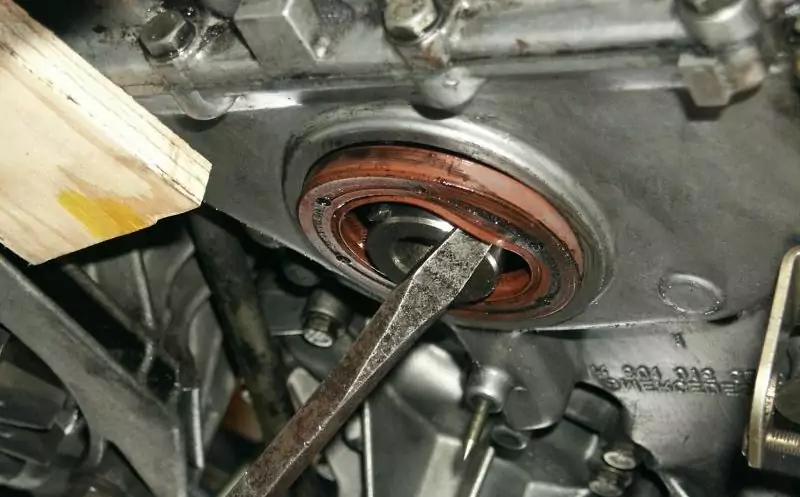Beneath your car’s hood lies the often overlooked crank seal. When it starts to leak, many wonder: is it still safe to drive? Dive into this short article as we break down the essentials of a crank seal leak, offering insights for both car enthusiasts and everyday drivers.

Is it Safe to Drive with a Crank Seal Leak?
It is not recommended to drive with a crank seal leak. If you continue to drive with a crank seal leak, it can cause serious damage to your engine. The oil that leaks out can cause damage to other engine components, and if the oil level gets too low, it can cause the engine to seize up. Driving with a crankshaft seal leak can be risky and can cause serious damage to your engine.
Here are some of the risks of driving with a crankshaft seal leak:
- Oil leaks: A crankshaft seal leak can cause oil to leak out of your engine, which can lead to low oil levels and engine damage.
- Engine damage: If the oil level gets too low, it can cause the engine to seize up, which can be expensive to repair.
- Environmental damage: Oil leaks can be harmful to the environment, as they can pollute waterways and harm plants and animals.
- Slippery surfaces: Oil leaks can create slippery surfaces on roads, driveways, and parking spaces, which can be dangerous for drivers and pedestrians.
It’s important to have a crankshaft seal leak repaired as soon as possible to prevent further damage to your engine and to avoid these risks. If you suspect that you have a crankshaft seal leak, it’s best to have it inspected by a mechanic and repaired as soon as possible.
Symptoms of a Crank Seal Leak
The crank seal, situated between the crankshaft and the engine block, plays a pivotal role in maintaining the lubrication of the engine by preventing oil from escaping. When this seal is compromised, it can lead to a host of symptoms that signify a potential problem.
Let’s delve deeper into the most common symptoms of a crank seal leak.
- Oil Spots on the Ground Where You Park Your Car: Perhaps the most immediate and noticeable sign of a leaking crank seal is the presence of oil spots or puddles under your vehicle. If you begin to observe these spots consistently after leaving your car parked overnight or for an extended period, it could be indicative of a leak.
- Low Oil Levels: Regularly checking your engine’s oil level is crucial for its health and longevity. If you’re having to top up your oil frequently, even without covering many miles, it’s a strong indication of a possible oil leak. A malfunctioning crank seal might be the culprit behind this depletion.
- Burning Oil Smell: When oil leaks from the crank seal, it might drip onto hot engine parts, leading to a distinct burnt oil aroma. If you start to catch whiffs of this unpleasant smell while driving or shortly after turning off your engine, it could point toward a leaking seal.
- Engine Misfires or Stalls: A compromised crank seal can lead to oil leaks that, in turn, may contaminate the spark plugs. This can result in the engine misfiring, leading to uneven power delivery, or even causing the engine to stall in severe cases.
- Smoke Coming from the Engine: In tandem with the burning oil smell, oil escaping from a leaking crank seal can produce visible smoke when it comes into contact with heated engine parts. If you observe smoke emanating from your engine, especially if it’s bluish in tint, it’s a strong indication that oil is burning off due to a leak.
Read more: What Causes a Crankshaft Seal to Leak: Top 6 Causes
Repair Options for Crank Seal Leak
If you suspect that you have a crank seal leak, it’s important to have it repaired as soon as possible. The cost of a repair can vary depending on the make and model of your vehicle, but it’s generally less expensive to repair a crank seal leak than it is to replace an entire engine.
Here are some repair options for a crank seal leak:
- Replace the seal: This is the most common repair option. The mechanic will remove the old seal and replace it with a new one.
- Replace the crankshaft: If the crankshaft is damaged, it may need to be replaced. This is a more expensive repair option.
- Replace the engine: If the damage is severe, it may be more cost-effective to replace the entire engine.
Conclusion
In conclusion, it is not safe to drive with a crank seal leak. If you suspect that you have a crank seal leak, it’s important to have it repaired as soon as possible to prevent further damage to your engine.
The cost of a repair can vary depending on the make and model of your vehicle, but it’s generally less expensive to repair a crank seal leak than it is to replace an entire engine.
Remember to perform regular maintenance on your vehicle to prevent future leaks and damage to your engine.
